Kitesurfing in Northern Regions: Techniques and Destinations

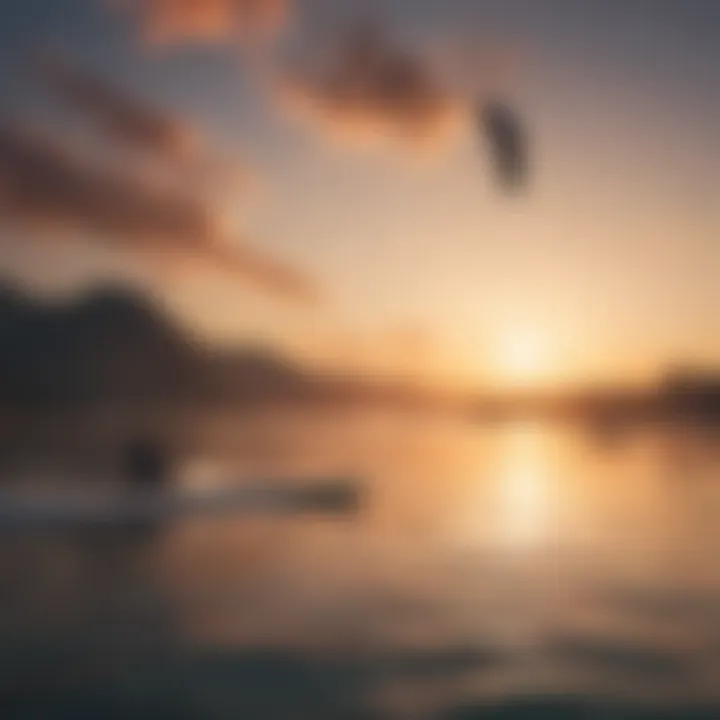
Intro
Kitesurfing in northern regions is a captivating experience, full of challenges and rewards. The interplay of wind, water, and skill creates a unique adventure that attracts many enthusiasts every year. With stark landscapes and diverse weather conditions, north kitesurfing offers not just thrills but also a chance to connect with nature in its rawest form. In this guide, we will navigate through the essential aspects of the sport, focusing on techniques, gear, and some must-visit destinations that define the northern kitesurfing scene.
As we dive into this topic, we’ll cover all the nitty-gritty details that both newbies and seasoned surfers may find enlightening. Understanding the intricacies of kitesurfing gear, from surfboards to harnesses, is crucial to improving performance on the water. Furthermore, grasping the techniques required for different skill levels will help in mastering the sport. We’ll also explore the geographical factors that influence kitesurfing in the north, highlighting how terrain and weather impact the experience.
Whether you fancy yourself as a wind warrior or just pondering about giving this thrilling sport a go, there’s something here for everyone. Let’s ensure you take away valuable insights into kitesurfing, enriched with tips for safe and responsible practice.
Surfboard Reviews
Choosing the right surfboard can make or break a kitesurfing session. The market is brimming with options, but understanding the different types of surfboards can guide you in selecting the one that caters to your style and skill level.
Types of Surfboards: An Overview
- Twintip Boards
These are the most common boards among kitesurfers, particularly popular in flat water areas. They allow for easy riding in both directions and suit beginner to intermediate levels. - Directional Boards
Ideal for surfing waves, these boards are designed to be ridden in one direction. They provide better control in choppy waters and add an element of agility in wave riding. - Foil Boards
Rising in popularity, foil boards lift above water when moving fast, creating a unique riding experience. They are excellent for flat waters and can be challenging but rewarding for skilled surfers.
When selecting a surfboard, consider your experience level, body weight, and the type of water conditions you plan to ride in.
Best Surfboards for Beginners and Pros
For beginners, the North Prime 135 is highly recommended, offering a solid mix of stability and maneuverability. It boasts user-friendly features, making it easier to learn the basics.
On the other hand, experienced surfers may find the Naish Hover 122 to be a perfect blend of performance and style. Designed for optimal speed and agility, it excels in both flat waters and waves, catering to an adventurous surfing style.
"Choosing the right board is like picking a dance partner; the right fit can make the moves effortless."
These boards exemplify how gear can sharply influence your performance. Now that we’ve laid out which surfboards could help you glide through the waters, let’s transition to the techniques that will ensure you ride like the wind.
Preface to Kitesurfing
Kitesurfing is not just a sport; it’s a unique blend of exhilaration and harmony with nature. In northern regions, where the winds howl and the surf mirrors the sky, kitesurfing takes on an added layer of depth. This section sets the stage for understanding the fundamentals of kitesurfing, especially as they pertain to northern climates. The mixture of powerful wind currents and variable weather demands a well-informed approach to both technique and equipment.
Understanding the core principles of kitesurfing can enhance not just the enjoyment of the sport but also the safety of every participant. Enthusiasts need to be aware of the factors that interplay between kite mechanics and environmental conditions. Having this knowledge can often be the difference between a mediocre ride and a thrilling experience.
The Evolution of Kitesurfing
Kitesurfing as we know it did not emerge overnight. It traces its roots back to various forms of kite flying in the early 13th century, where the idea of harnessing wind forces began. The modern incarnation, however, began to take shape in the late 20th century, initially driven by a handful of inventors experimenting with different designs. During the 1980s, commercial kites became available, providing surfers with the means to ride the waves using power from the wind above.
Over the decades, kitesurfing has continued to evolve with advancements in kite technology and materials. The shift from inflatable kites to leading-edge inflatable designs in the 1990s significantly improved safety and user-friendliness. Notably, brands such as North Kites made substantial contributions to this shift. The development of shorter, stiffer boards has also transformed how riders maneuver on water, allowing for greater control and speed.
Not stopping there, the growth of community and competitive events has only fueled its evolution. As more riders gravitate toward northern locations, the need for specialized gear and techniques has prompted transformations in the sport's landscape. Understanding this evolution not only provides context but also underscores the continual innovation that defines kitesurfing today.
Understanding Kitesurfing Dynamics
The dynamics of kitesurfing heavily rely on the interplay between wind, water, and rider. Each kitesurfer must develop an intuition for how their kite interacts with the wind. It’s akin to dancing with the elements—every pull on the steering lines can lead to dramatic shifts in performance.
Environmental variables in northern regions profoundly affect these dynamics. Wind patterns can be unpredictable, interspersing calm periods with sudden gusts. Riders must be able to read the signs of changing conditions. In such locations, the saying "the wind has its own mind" rings especially true. Kite angles and control should be adjusted to harness these erratic fluctuations maximally.
Equally significant is the understanding of how water conditions can vary with geographic and climatic factors. Cold water presents its own challenges, affecting buoyancy and drag. Hence, a solid grasp of how these elements interact is fundamental. Engaging with this knowledge equips kitesurfers to make informed decisions about techniques, timing, and safety measures.
By delving into these foundational aspects, we prepare ourselves to tackle more advanced techniques and select the right equipment for northern conditions in the sections that follow.
Special Considerations for Northern Kitesurfing
When one takes to the waters in northern regions for kitesurfing, the nuances of local conditions can make or break an experience. From dealing with fluctuating temperatures to understanding the intricacies of wind patterns, there's a lot to reckon with. It’s not just about strapping on a board and soaring above the waves; it’s about having a keen awareness of the elements at play. Ignoring these factors can spell trouble, while being informed enhances both safety and enjoyment on the water.
Climate and Weather Patterns
Kitesurfing in the north is no summertime breeze. The climate can be unpredictable, and thus a thorough understanding of weather patterns becomes essential. Northern regions often showcase a mix of temperate and cold climates, with sudden shifts that may catch even seasoned surfers off guard.
For example, take Norway's coastline. You might find yourself basking in mild temperatures during the day, only to face chilling winds once the sun dips behind the fjords. Factors like local geography, such as mountains or forests, can drastically affect wind direction and strength.
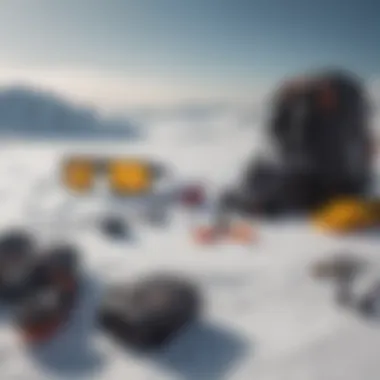
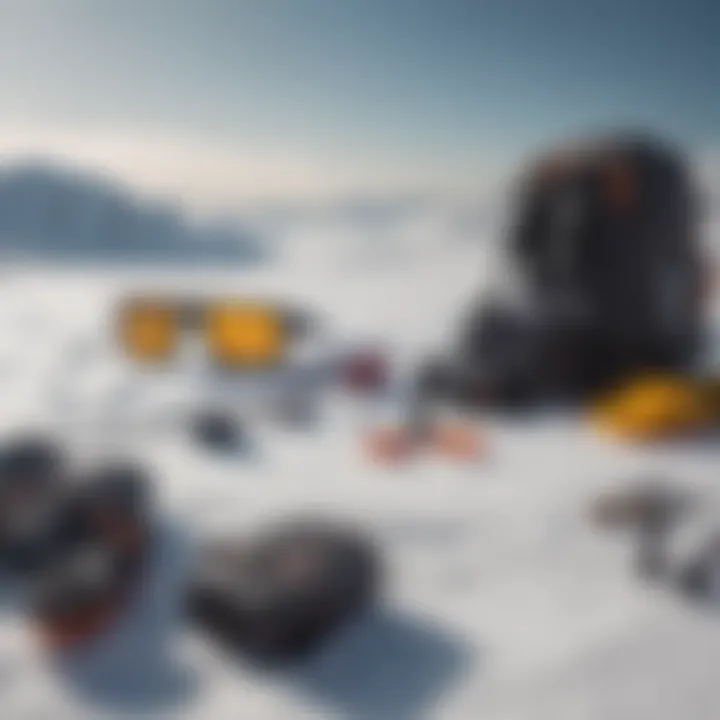
It's prudent for kitesurfers to keep an eye on local forecasts, but also to foster a sense of intuition about the environment. Being able to read the sky and feel the breeze can inform a surfer when it’s time to launch or when to pack it up for the day.
Seasonal Variations and Their Impact
Different seasons bring new challenges and unique opportunities for kitesurfers in northern areas. In the summer, long days and warmer weather can be enticing, but they often come with their own set of complications. Winds may be lighter, requiring surfers to adjust their kites and techniques to keep up with the conditions. Conversely, the winter months can present harsh winds and frigid water temperatures, calling for a completely different approach to both gear and safety.
It's during the transition seasons—spring and autumn—that a nuanced understanding of seasonal variations truly pays off. The winds can be both stronger and more consistent during these times, yet unpredictable weather changes can occur rapidly.
For instance, in the fall along the eastern shores of Canada, kitesurfers can experience spectacular wind patterns as storms approach. However, temperatures can plummet, necessitating the correct gear for both safety and comfort. Understanding these seasonal intricacies is vital for anyone looking to fully enjoy the sport in northern locales.
"Knowing your spot and the seasons is like reading a book before diving into it—there’s so much more depth to the tale if you take the time to investigate."
Essential Equipment for Northern Conditions
In the realm of kitesurfing, especially in northern regions with their unique challenges, having the right equipment is like having a solid foundation for a house. It’s vital to ensure safety and enhance performance on the water. The climate, wind patterns, and water conditions in these areas can be fickle, necessitating specific gear tailored to these environments. When equipped with suitable tools, kitesurfers can navigate the sometimes harsh elements and enjoy their sport to the fullest.
Choosing the Right Kite
Selecting the appropriate kite is paramount for a successful kitesurfing experience in the north. The kite’s size and type directly impact your control, speed, and stability on the water. For conditions that are variable, a versatile kite, such as a bow kite or delta kite, can be advantageous. These designs are more forgiving in gusty winds, giving riders a better sense of confidence.
Key Considerations for Kite Selection:
- Size: Opt for a larger kite if you're in light wind conditions to maintain lift, but an oversized kite can be cumbersome in strong winds.
- Material: Look for kites made from high-quality materials that are both durable and resistant to wear and tear.
- Design Features: Kites with adjustable bridle settings allow adjustments based on local wind conditions, providing a great deal of flexibility.
Remember, a well-chosen kite can make the difference between a smooth ride and a challenging experience.
Wetsuits and Gear Adaptations
With biting temperatures in the northern seas, having adequate thermal protection cannot be overstated. The right wetsuit serves not only as insulation but also as a barrier against wind chill. Neoprene is the typical material used. Depending on the water conditions, wetsuits come in various thicknesses—usually ranging from 3/2 mm for milder temps to 5/4 mm or even thicker for frigid waters.
Adaptations to Consider:
- Layers: Wearing rash guards underneath can enhance comfort and add extra warmth.
- Hoods and Gloves: Adding these items can help retain body heat, ensuring that you stay in the water longer without feeling the cold seep in.
- Booties: Appropriate footwear protects your feet from sharp objects and provides insulation against cold.
Gear adaptation is essential, as feeling uncomfortable can lead to a less enjoyable session and might even compromise safety.
Safety Equipment: Must-Haves
Safety is an integral part of kitesurfing, more so in northern regions where the conditions can turn quickly. Proper safety equipment can be the difference between a minor mishap and a serious incident. Therefore, kitesurfers must prioritize their safety gear along with their kites and boards.
Essential Safety Gear Includes:
- Impact Vests: These not only offer buoyancy but also protect against impacts, particularly if you fall hard on the water.
- Helmets: Crucial in protecting your head during jumps and potential falls, helmets can prevent serious injuries.
- Leashes and Safety Releases: Ensure the kite is attached securely to you and can be released quickly in an emergency.
It's better to have and not need than to need and not have.
Being equipped with the right safety apparatus allows for a more relaxed experience on the water, encouraging kitesurfers to push their limits while still being prepared for the unexpected.
Taking time to select the right gear tailored to northern conditions is not just about performance—it’s about enjoying your time on the water safely. As you gear up, consider these factors for a more successful and enjoyable kitesurfing adventure.
Technique Mastery for Successful Kitesurfing
Mastering kitesurfing technique is crucial for several reasons. For one, it enhances both safety and performance, especially in the dynamic conditions found in northern waters. Without proper techniques, even the most expensive gear won’t yield the expected excitement and enjoyment; instead, it may lead to frustrating experiences or, worse, accidents. Thus, diving into proper techniques is not just advisable, it's essential for ensuring a thrilling yet responsible sporting experience.
Launching and Landing Techniques
Launching and landing are two of the most critical skills in kitesurfing, particularly given the potential for variable winds in northern areas. Timing is everything. The goal is to avoid complications while ensuring that the kite safely ascends and descends.
- Launching: Start by setting up your kite in the direct wind window - the area of the wind that gives your kite the best lift. Make sure to pay attention to the local etiquette; never launch in crowded areas. A proper signal to your helpers is non-verbal and indicates you’re ready to go. At the exact moment the kite is ready, your team should smoothly guide it overhead to the zenith of your launch.
- Landing: Just as important, landing should be approached with caution. Command your kite to drop into a controlled descent. Ideally, you want to land downwind to lessen tension on the lines and avoid crashing the kite into an obstacle or even a fellow kitesurfer. This controlled landing, paired with a gradual release of tension in the lines, will ensure the kite gently meets the ground instead of crashing down.
Proper launching and landing techniques can transform a potentially chaotic moment into an effortless process.
Controlling Speed and Direction


Among the finer points of kitesurfing is the ability to maintain control over your speed and direction. This might sound straightforward, but it can truly make the difference between a leisurely glide and an exhilarating ride.
- Sheeting In and Out: The kite's angle affects speed. Pulling the bar towards you (sheeting in) increases lift and speed while pushing it away (sheeting out) decreases speed and helps in turning. Finding the sweet spot is key – too much pull will result in loss of control.
- Edge Control: When you're on the board, how you position your feet can dictate speed. Lean back on your heels for more grip on the water to slow down or shift your weight forward for acceleration. Feet positioning while turning also allows for seamless direction change, increasing your fluidity on the board.
With practice, mastering these controls can lead to smooth transitions and enhance the overall experience.
Jumping and Tricks: Advanced Techniques
For many kitesurfers, jumping and performing tricks is the hallmark of skill. While exhilarating, it requires precision and an understanding of wind and kite dynamics.
To take your skills to new heights, consider the following:
- Pop Technique: The key to jumping is to perform a proper pop. This maneuver involves bending your knees and then pushing them down quickly while pulling the bar in towards your chest. This action compresses the springs of your body before unloading it upwards into the jump.
- Kite Position: During a jump, positioning the kite correctly is essential. Keep the kite above your head and slightly forwards to help with lift. A common mistake is letting the kite drop, which results in insufficient height.
- Landing Tricks: As you descend, your eyes should be focused on where you intend to land, as this will safeguard against potential wipeouts. As your feet meet the water, be sure to maintain your kite’s position to ensure a clean landing – transitioning out of your jump into a smooth ride is what showcases real skill.
Practicing these tricks within a safe environment is advisable. This way, you can truly understand how small adjustments impact your flight, boost your confidence, and encourage proper technique evolution.
Learning and mastering these kitesurfing techniques is a continuous journey which can be both thrilling and empowering. As you polish these skills, they contribute to not just enhancing personal enjoyment but elevating the entire kitesurfing community.
Best Kitesurfing Locations in Northern Regions
Kitesurfing in northern regions offers an exhilarating experience that stretches beyond just the thrill of flying across waves. The locations one chooses to ride greatly influence not only one’s performance but also overall enjoyment. From vast windswept beaches to secluded lakes, the diversity in Northern kitesurfing spots provides opportunities for surfers of all skills.
Incorporating the right kitesurfing spots into your routine isn’t a trivial matter. The variety of climates, wind conditions, and geographic profiles contributes significantly to the sport. You got to consider factors like wind consistency, water depth, and local regulations that often govern kitesurfing activities. A well-selected location can enhance your skills while ensuring safety. So, let's get into some of the popular places where you can kitesurf and uncover those hidden gems that might just be your next favorite spot.
Popular Kitesurfing Spots
- Tarifa, Spain
Known as the kitesurfing capital of Europe, Tarifa boasts consistent wind, warm waters, and a vibrant kitesurfing community. With conditions that are suitable for both novices and experts, it’s a spot that simply cannot be missed. - Hatteras, North Carolina
Often referred to as the “East Coast’s best-kept secret,” Cape Hatteras offers thrilling flat waters alongside some incredible wave locations. The winds here, especially during the spring and fall, can be downright perfect for kitesurfing. - Maui, Hawaii
Famous for its breathtaking views and explosive wind action, Maui’s north shore is perfect for those looking to catch some serious waves. The Kanaha Beach Park is particularly recommended, with its warm water and stunning scenery. - Vassiliki, Greece
Another well-known spot, Vassiliki is cherished for its reliable thermal winds. The calm bay offers an excellent area for beginners, while the outer zones are perfect for seasoned riders who enjoy a good challenge. - Lofoten Islands, Norway
A true marvel for adventurous souls, the Lofoten Islands present stunning Arctic vistas and thrilling wind conditions. Whether you're looking for flat-water spots or challenging swells, this destination provides it all, along with a unique experience of kiting under the midnight sun.
Considerations:
- Be aware of crowds during peak seasons, as popular spots can get packed.
- Local laws and regulations can vary greatly from one region to another. Always check before you ride.
- Weather patterns change rapidly in northern areas; prepare for unexpected shifts.
Hidden Gems: Lesser-Known Destinations
While the popular kitesurfing hotspots have their charm, discovering lesser-known locales can be just as rewarding. These hidden gems often offer serenity, untouched nature, and a welcoming community atmosphere. Here are a few spots worth exploring:
- Sæbø, Norway
Nestled between steep mountains and serene waters, Sæbø is a quiet kitesurfing paradise. It offers a stunning backdrop along with consistent winds, making it a peaceful escape for kitesurfers looking to hone their skills without the buzz of larger crowds. - Tampere, Finland
This inland city features numerous lakes that are ideal for kitesurfing in the summer months. The area showcases a blend of calm waters and beautiful surroundings, and it’s a great alternative for those who want to get away from the sea. - Lamu Island, Kenya
Though slightly off the beaten path, Lamu's waters are both warm and breathtaking. The island invites kitesurfers with its consistent winds and shallow lagoons, perfect for all skill levels. - Svalbard, Norway
For the thrill-seekers, Svalbard offers the chance to kite surf amidst stunning glaciers and tundra landscapes. It’s a place best suited for experienced riders looking to test their skills in unique conditions. - Folgefonna Glacier, Norway
Kitesurfing on glacial waters might sound like a wild adventure – and it is. The pristine environment combined with powerful winds creates a thrilling kitesurfing experience in one of the most scenic locations imaginable.
A Few Points to Keep in Mind:
- Access: Ensure the spots have reliable access to launch areas and parking.
- Facilities: Some hidden gems may lack facilities like bathrooms or restaurants; small details like this matter.
- Weather: Less popular spots may have unpredictable weather, so check forecasts before you go.
Kitesurfing in northern regions can be an unforgettable experience if you choose your locations wisely. Each site presents its own unique blend of wind, water conditions, and natural beauty, making for days filled with exploration and joy.
Environmental Considerations in Kitesurfing
Understanding the environmental factors surrounding kitesurfing is crucial for anyone engaging in this sport, particularly in northern regions. Kitesurfing isn't just about excitement and adrenaline; it's also about respect and responsibility towards the natural landscapes where enthusiasts partake in their watersport. The interplay between the activity and the environment shapes not only the experience but also the sustainability of these locations. Therefore, educating oneself on environmental considerations serves as a cornerstone for responsible kitesurfing practices.
Sustainable Practices for Kitesurfers
To ensure that kitesurfing remains enjoyable for generations to come, enthusiasts need to adopt sustainable practices. These can range from selecting eco-friendly gear to being mindful of local ecosystems. Here are several practices to keep in mind:
- Choose Eco-friendly Gear: Opt for kites and boards made from sustainable materials. Brands are slowly shifting towards eco-conscious manufacturing processes, and supporting these companies promotes a greener industry.
- Limit Water Pollution: Be cautious with your waste. This includes being responsible with sunscreen and ensuring any non-biodegradable waste is removed from the beach. Even biodegradable products can have adverse effects in delicate marine environments.
- Respect Wildlife: When kitesurfing, choose spots that are not directly in protected marine areas or during migration seasons. Avoid disturbing nesting sites or areas where wildlife is breeding.
- Educate Yourself and Others: Understanding the local environment helps identify best practices concerning ecology. Sharing knowledge among fellow kitesurfers amplifies the impact of those sustainable choices.
Adopting these practices doesn't just improve kitesurfing conditions; it enhances community awareness and builds stronger ties among kitesurfers, fostering a deeper respect for nature.
Protecting Marine Ecosystems
The marine ecosystems that provide stunning backdrops for kitesurfing are delicate and often vulnerable to human activities. As kitesurfers, the onus is on us to protect these environments. Here are ways to contribute to marine conservation:
- Stay Informed About Local Regulations: Before hitting the water, ensure that you know any specific regulations regarding kitesurfing in that area. Laws are often put in place to protect both marine habitats and human users.
- Monitor Your Impact: Take note of how your actions may affect the shoreline and the waters you are riding on. Engage in practices such as reducing your speed near shallow waters, thereby minimizing damage to corals and seagrasses.
- Participate in Clean-Ups: Joining or organizing beach clean-ups can make a big difference. These events not only improve the surroundings but also foster a sense of community among kitesurfers and other water sports enthusiasts.
By taking an active role in protecting marine ecosystems, kitesurfers can play a substantial part in ensuring that the beautiful waters and coastlines we enjoy remain unspoiled.
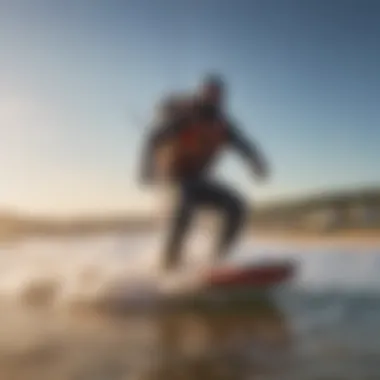
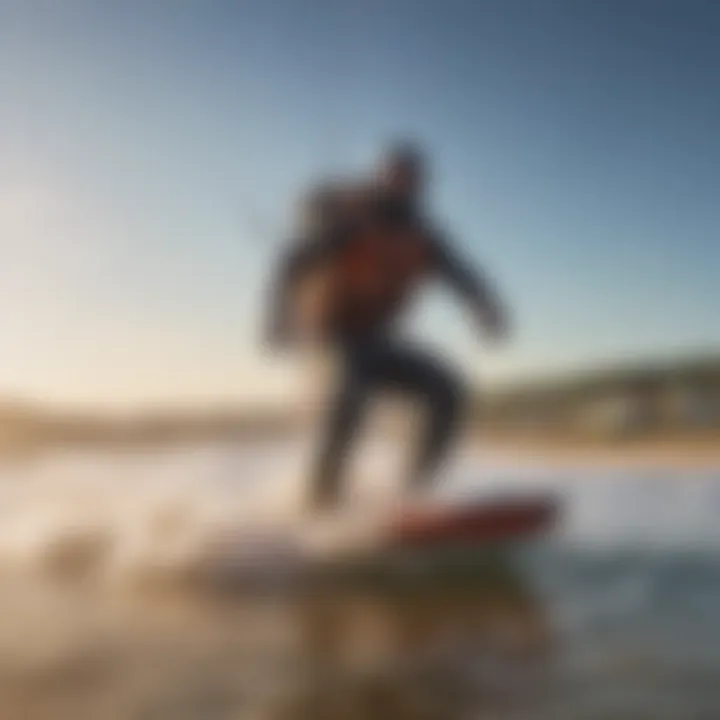
"The true spirit of kitesurfing involves an appreciation for nature that goes beyond the thrill of the ride. The responsibility lies in our hands to cherish and preserve these incredible environments".
Navigating the world of kitesurfing requires more than just the right techniques or equipment; it demands a committed acknowledgment of our environmental responsibilities. Not only is this important for the longevity of the sport, but it's also essential for maintaining the beauty and integrity of our natural surroundings.
Community and Culture of Kitesurfing
Kitesurfing is not just a sporting activity; it’s a way of life that encompasses a unique culture and community. This section focuses on what makes the kitesurfing community so special and how it shapes the overall experience of those involved. From camaraderie and shared experiences to the cultural tapestry woven by traditions and competitions, understanding this element is crucial for anyone looking to delve deeper into this thrilling sport.
Building a Kitesurfing Community
A strong kitesurfing community serves as a backbone for participating individuals. It creates a network of support, where newcomers can learn from experienced surfers and enthusiasts alike. There is a wild mix of skills among kitesurfers, ranging from novices trying their first jumps to veterans mastering complex maneuvers. This diversity fosters an environment rich with shared knowledge and skills.
- Friendships and Connections: The thrill of catching wind and waves often brings people together. Many kitesurfers will recount stories of meeting lifelong friends on the shore during a sunrise session. These friendships often extend offline, leading to group outings and trips.
- Mentorship Opportunities: Seasoned kitesurfers frequently take newcomers under their wings. This mentorship not only accelerates learning but also enriches the community. Beginners gain confidence, while veterans find joy in teaching and seeing progress.
- Inclusivity: Kitesurfing communities are generally welcoming, regardless of a person’s background or skill level. This openness encourages participation from people of all walks of life, enhancing the community’s richness. Therefore, events, including local meetups and beach clean-ups, are organized, creating more interactions and engagements.
"In the world of kitesurfing, it's not just about the ride; it's about who you ride with."
As communities grow, the challenges faced can shift too. Issues might arise around crowded spots or conflicting interests. Nevertheless, a good community will cultivate discussions surrounding regulations and guidelines to ensure everyone can enjoy the wind and waves.
Events and Competitions
Events and competitions play a pivotal role in uniting kitesurfers and showcasing the sport’s vibrant culture. They serve not only as platforms for talented individuals to shine but also as social gatherings that promote community spirit.
- Local Contests: Community-driven contests are often held at local beaches. These events are typically informal, allowing anyone to participate. They focus on fun rather than strict competition, encouraging newcomers to test their skills in a supportive atmosphere.
- International Competitions: Larger events like the World Kiteboarding League attract kitesurfers from around the globe. These competitions display remarkable talent and innovation, captivating audiences with breathtaking performances. Such events also encourage local economies by drawing tourists eager to watch.
- Culture and Celebration: Events often include cultural elements, like music and food, further enhancing the experience. These gatherings become celebrations of not just kitesurfing but creativity and culture, solidifying the bond among community members.
Safety Protocols in Kitesurfing
Kitesurfing in northern regions offers thrilling experiences, but it comes with its own set of challenges and risks. Understanding and implementing safety protocols is crucial for anyone looking to engage in this exhilarating sport. When you’re out on the water, the dynamics can change rapidly due to varying wind conditions, boat traffic, or unexpected weather shifts. Using solid safety protocols ensures not only your safety but also the wellbeing of others around you.
Understanding Local Regulations
Local regulations are the backbone of safe kitesurfing practices. Every region may have its own set of rules governing where and when you can kite. In northern regions, these regulations often reflect environmental concerns, local wildlife, as well as safety protocols that have been established over the years.
- Designated Kitesurfing Areas: It’s imperative to familiarize yourself with areas specifically designated for kitesurfing. These are chosen to reduce conflicts between other water sports and kitesurfers, ensuring a safer environment for everyone.
- Time Restrictions: Some locations may impose time restrictions, prohibiting kiting during certain hours. This may be due to local wildlife activity, such as nesting birds or peak fishing times.
- Safety Equipment Mandates: Different areas may have regulations regarding mandatory safety gear. Check if life jackets or helmets are required, as some regions prioritize these for kitesurfers' safety.
- Environmental Protections: Many northern areas are home to sensitive ecosystems. Regulations are often in place to protect these regions from disturbances, so it’s essential to be aware of where you are allowed to ride.
When in doubt, consult with local kitesurfing communities or organizations which can provide information on current regulations.
Emergency Procedures and First Aid
Accidents can happen, even with the best planning. That’s why knowing emergency procedures is critical for every kitesurfer. Here’s a rundown of some important procedures to keep in mind:
“Preparation is key; knowing what to do makes all the difference in a crisis.”
- Being Proactive: Carry a first aid kit that includes essentials such as bandage, antiseptic wipes, and any personal medications. A waterproof bag for your valuables is also recommendable.
- Communication Devices: Ensure you have a reliable communication device. Local cell service is a must for contacting emergency services, and a two-way radio can also be helpful, especially in isolated areas.
- Self-Rescue: Familiarize yourself with self-rescue techniques. If you find yourself in trouble, such as being dragged by the kite or a sudden drop in wind, knowing how to depower the kite quickly could save your life.
- Swift Response to Injuries: If someone is injured, remain calm. Assess the situation before acting. If needed, follow basic first aid procedures such as checking for responsiveness or controlling any bleeding.
- Calling for Help: Be sure to know the number for local emergency services, as this can differ from country to country. Quick action can prevent minor injuries from becoming severe problems.
In essence, while kitesurfing in northern regions is about catching wind and waves, prioritizing safety protocols and procedures will ensure that you enjoy the sport while minimizing risks. By understanding local regulations and being prepared for emergencies, you set yourself and others up for a safer, more enjoyable experience.
Culminations: The Future of Kitesurfing in Northern Regions
As we look at the future of kitesurfing in northern areas, it becomes clear that the sport is not just a pastime but increasingly an influential part of local economies and cultures. With every gust of wind and wave, there's potential for growth and development. Kitesurfing has a way of bringing people together, fostering communities, and encouraging exploration of often pristine and remote coastal areas that might have otherwise gone unnoticed.
Trends and Innovations
The kitesurfing industry is on the brink of several exciting transformations. Innovations in kite design, ranging from lightweight materials to improved stability features, have enhanced performance and safety. Neat technologies such as automatic kite inflation and smarter control systems are make it easier for newcomers to join the ranks of seasoned kitesurfers.
Moreover, environmental sustainability is becoming a cornerstone of the industry. Brands recognize that protecting the places where we recreate is essential for the longevity of the sport. As such, there is a growing trend towards eco-friendly materials, such as biodegradable kites and recyclable components. Local kitesurfing schools are also adopting practices that minimally impact marine ecosystems, ensuring that the thrill of riding the waves does not come at the cost of our environment.
New kitesurfing locations are also being discovered as adventurers seek out pristine spots off the beaten path. From the rugged shores of Norway to the serene beaches of Greenland, these areas promise an untouched beauty that adds to the allure of kitesurfing.
"Exploring new spots not only brings freshness to the sport but also underscores the importance of preserving these environments for future generations."
Final Thoughts on Responsible Kitesurfing
As the wave of kitesurfing continues to grow, it’s essential to embrace a mindset of responsibility. Practice discernment regarding where and when to kite, as conditions can vary drastically across northern regions. Not every spot is suitable on any given day. Knowing this can help prevent accidents and protect the experience for everyone.
Engaging with local communities, understanding regulations, and participating in beach clean-ups can make a significant difference. Kitesurfers are guests in nature, and it is our duty to respect the land and sea we enjoy. The future hinges on cultivating a culture that prioritizes respect for our surroundings, ensuring that other adventurers can partake in the beauty of kitesurfing.
Ultimately, the future of kitesurfing in northern regions looks bright. Through trends in innovation and a collective commitment to responsibility, this exhilarating sport can flourish for years to come.
As you chart your sailing adventure, keep these guiding principles in mind. The horizon is vast and full of promise.















